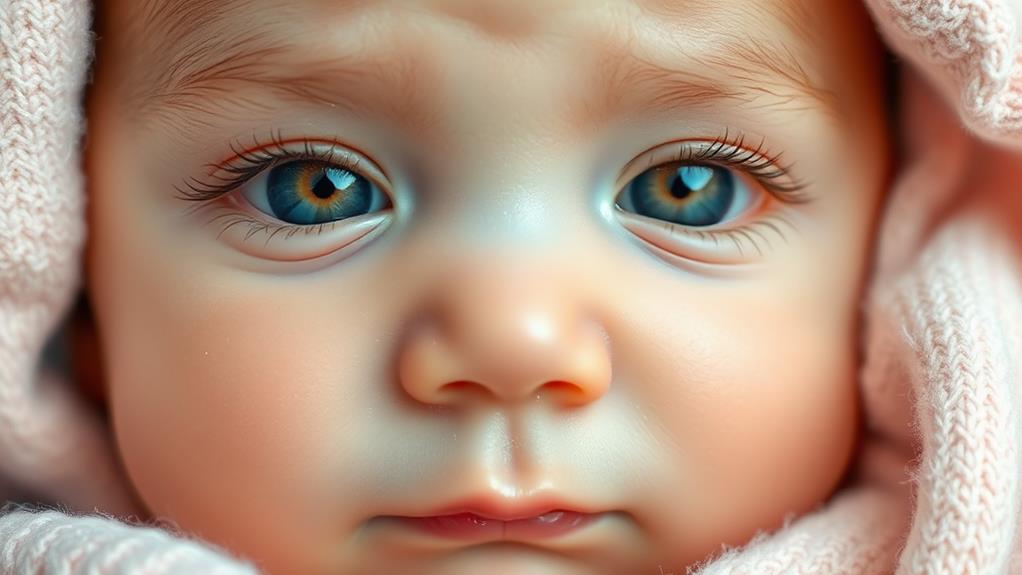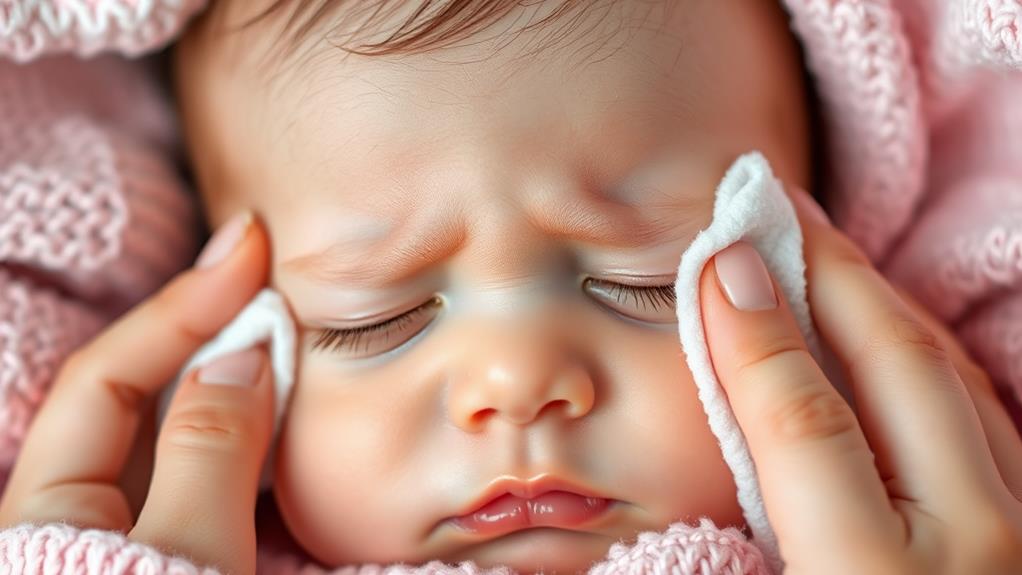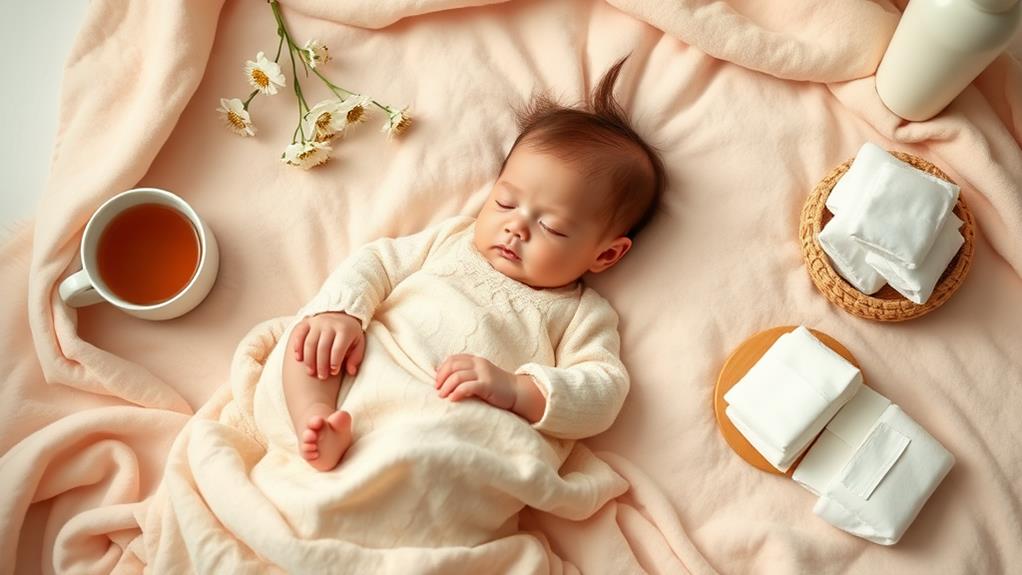If you've noticed your baby's eyes are sticky, you're likely wondering what could be causing this and how to address it. Sticky eyes can stem from a few common issues, such as blocked tear ducts or infections like conjunctivitis, leading to discomfort and unsightly discharge. While there are some effective home remedies you can try, it's essential to recognize when professional medical advice is needed. Understanding the underlying causes is crucial, especially since some cases can require more serious interventions. What are the signs you should be on the lookout for?
Understanding Sticky Eyes

Understanding sticky eyes in babies can be concerning for parents, especially when you notice your little one's eyes becoming watery and crusty. Sticky eyes are often caused by blocked tear ducts, which affects about 1 in 20 newborns. You might see yellow or green discharge, and while it can look alarming, most of the time, it's painless. It's just those pesky blocked tear ducts causing trouble!
These blockages might happen due to mucus or tiny cellular plugs that form while your baby is still developing. The good news? About 95% of these cases clear up on their own by the time your little one turns one.
If you notice excessive tearing or crusty eyelids, it's a good idea to clean your baby's eyes gently with a warm, damp cloth. This can help keep things tidy!
If symptoms persist beyond a year, it's wise to seek medical advice. Sometimes, a condition called congenital nasolacrimal duct obstruction can require a bit more attention, including possible surgical intervention.
But don't worry too much—most cases resolve naturally, and your baby will be back to their adorable self in no time!
Common Causes of Sticky Eyes
Sticky eyes in babies can arise from several common causes beyond blocked tear ducts. One of the most frequent culprits is a blocked tear duct, which happens in about 1 in 20 infants. This can lead to persistent watering and yellow or white discharge.
Another common cause is conjunctivitis, or pinkeye, which involves inflammation of the conjunctiva. You might notice red eyes and discharge, usually appearing 1 to 12 days after birth, depending on what's causing it.
Environmental factors can also play a role. If your baby is exposed to irritants or allergens, it might lead to eye discharge and irritation. Additionally, congenital issues like narrow or malformed tear ducts can cause sticky eyes, so keep an eye on things to see if intervention is needed.
While sticky eyes are often harmless, it's essential to know when to act. If you see redness, swelling, or a fever, don't hesitate to reach out to your doctor.
In the meantime, you can gently clean your baby's eyes with a soft, damp cloth to help keep things tidy!
Symptoms to Watch For

Noticing changes in your baby's eyes can be concerning, especially when it comes to sticky eyes. You might see some watery eyes, and that sticky discharge could be yellow or green. This often happens when a tear duct gets blocked, causing your little one's eyelashes to stick together, especially after their nap.
Keep an eye out for redness in the whites of their eyes, as well as any swelling around them. If you notice your baby becoming more irritable than usual, that could signal something's not quite right.
Sometimes, they might even have trouble opening their eyes because of swelling, or they could be experiencing severe pain and redness. If that happens, it's time to contact a doctor right away.
Also, if these sticky symptoms persist beyond a year, it's a good idea to get a professional to check it out.
When to Seek Medical Help
It's important to know when to seek medical help for your baby's sticky eyes. If you notice sticky discharge that's yellow or green, it could mean an infection, so don't wait—contact your GP right away.
Also, if there's significant redness in the whites of the eyes or swelling around them, that's a sign you should get help. If your little one can't open their eye due to swelling, that's another red flag.
Keep an eye out for signs of severe pain, persistent redness, or if your baby seems to be having trouble breathing—urgent care is necessary in these cases.
Dehydration is another concern, so watch for signs like a dry mouth or sunken eyes. If you see these, it's best to reach out to a doctor.
For less urgent issues, if those sticky eyes don't clear up after 12 months or if you notice any concerning changes in the discharge, it's time to consult your healthcare provider.
Home Remedies for Sticky Eyes

If your baby's sticky eyes aren't showing signs of serious issues, several home remedies can help alleviate the problem.
First, you can clean your baby's eyes using a cotton ball soaked in cooled boiled water. Just wipe gently from the inner corner to the outer corner to remove any discharge. This can help prevent irritation, too!
If you suspect a blocked tear duct, try giving that area a gentle massage. Roll your finger between the eye corner and the nose to encourage drainage. It's like giving that tear duct a little pep talk!
Another great option is breast milk. Thanks to its antibacterial properties, you can apply a few drops to the affected eye with a clean cotton swab. It's like nature's little helper!
Remember to wash your hands thoroughly before and after you clean your baby's eyes. This helps keep germs away.
And if the sticky eye symptoms persist beyond 12 months or seem to worsen, don't hesitate to consult a healthcare professional. After all, your little one deserves the best care!
Hygiene Practices for Eye Care
Maintaining proper hygiene is essential for your baby's eye care, especially when dealing with sticky eyes. It's a common issue, and keeping things clean can make a big difference!
Start by washing your hands thoroughly before and after cleaning your baby's eyes. This simple step helps prevent the introduction of bacteria.
Use sterile cotton balls or clean tissues soaked in cooled boiled water to gently wipe the affected eye. Always wipe from the inner corner to the outer corner, and remember to toss each cotton ball after use. Sharing towels or cleaning supplies isn't a good idea, as it can spread infections.
Stick to separate supplies for each cleaning session to keep everything hygienic. Creating a clean environment is key, too! Regularly wash items that touch your baby's face, like blankets and toys, to reduce any blocked tear ducts.
Lastly, ensure that cleaning materials are free from irritants or fragrances. You want to soothe those eyes, not make things worse! By following these hygiene practices, you can help keep your baby's eyes healthy and happy.
Medical Treatments Available

When sticky eyes persist despite good hygiene practices, it may be time to explore medical treatments. If your baby has sticky yellow discharge or shows signs of redness, it could indicate an infection, often linked to blocked tear ducts. In such cases, your doctor might prescribe antibiotic eye drops or ointments to help clear it up.
Before jumping into treatments, remember that you can still treat it at home! Using a gentle saline solution can help flush out irritants and soothe your little one's eyes. Regular pediatric check-ups are essential, as they help monitor your baby's eye health and determine if further medical treatments are needed.
If your baby develops symptoms like swelling or thick discharge, it's crucial to seek immediate medical attention, as these might indicate a more serious infection called dacryocystitis.
While gentle eye massages might be suggested by your healthcare provider to relieve blockages, keep an open line of communication with them about your concerns.
Surgical Options for Persistent Cases
For some babies, sticky eyes can become a persistent issue that requires more than just home remedies. If your little one's symptoms stick around past 12 months, it might be time to consider surgical intervention.
The most common procedure is called nasolacrimal duct probing, which helps clear any blocked tear ducts. This quick surgery is usually done as a day case, meaning your baby can go home the same day. They'll be under short general anesthesia, so they won't feel a thing.
Plus, there are no scars or stitches, making it a minimally invasive option. The success rate for this procedure is around 75%, which is pretty good when it comes to resolving those pesky symptoms.
While complications are rare, it's still essential to monitor your baby's recovery afterward. This way, you can ensure the blockage is fully resolved. Remember, a little patience goes a long way!
If you're considering this option, just know you're not alone in this journey, and many parents have found relief for their little ones through this procedure.
Monitoring and Follow-Up Care

Effective monitoring and follow-up care are crucial in managing sticky eyes in babies. You'll want to keep a close eye on your little one's symptoms. Make sure to track how often their eyes get sticky and what kind of discharge you see. This information can be super helpful for your healthcare professional during check-ups.
Regular pediatric visits are important, especially if those symptoms stick around past 12 months. Follow-up appointments may be necessary to see if your home care is doing the trick or if more help is needed.
If you notice any signs of infection, like increased redness or swelling, don't wait—seek medical attention right away. It's always better to be safe than sorry!
If you've been trying home care strategies for a few weeks and there's no improvement, consult with a healthcare professional. They can help figure out the next steps.
Additional Resources and Support
Finding the right support can make a big difference when you're managing sticky eyes in your baby. First off, don't hesitate to reach out to services like NHS 111. They can give you immediate advice and support, plus direct you to local health services if necessary. It's like having a friendly guide right at your fingertips!
You might also want to check out some educational resources. Many healthcare providers offer helpful videos and pamphlets about sticky yellow discharge and conditions like blocked tear ducts. These resources can help you understand what's happening and when it's time to seek medical help.
Community health initiatives often host information sessions where families can learn about eye health in kids. These sessions can be a great way to connect with others and gather useful tips.
Plus, support groups and online forums are excellent for sharing experiences. You'll find parents who've been through the same thing, and their advice can be invaluable.
Don't forget about pediatric ophthalmologists! They typically have brochures and consultations available to explain treatment options and preventive measures.
With these resources, you're not alone in this journey. You've got this!

